Mountain Pine Beetles

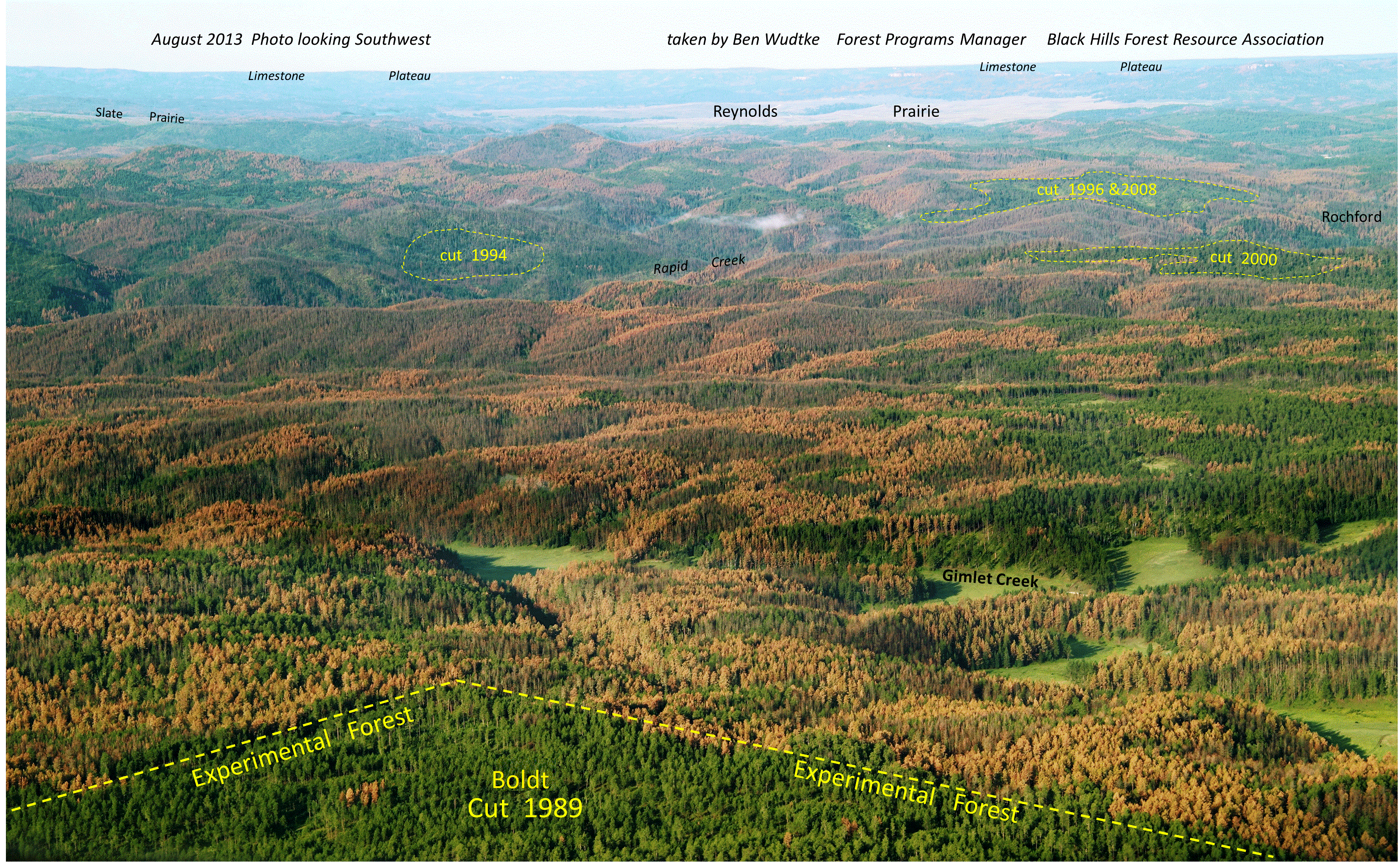
Forest Management and Timber Sales Succeed at Suppressing Mountain Pine Beetle Populations!
The Recent Epidemic
During the most recent mountain pine beetle epidemic in the Black Hills, approximately 435,000 acres were impacted to some extent by the mountain pine beetle in the Black Hills region. There have been many successes in the Black Hills at keeping mountain pine beetle populations suppressed through active forest management and timber sales and were only possible through the collaborative efforts of multiple stakeholders contributing to the suppression efforts. Support from the local counties, State of South Dakota, Federal agancies, and forest products companies has made our successes possible in the Black Hills. Just as some battles have been won, in many other areas the battle has been lost and the region has seen areas of extensive tree mortality as a result of the mountain pine beetle.
Biology:
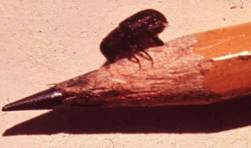
The mountain pine beetle (Dendroctonus ponderosae) is one of several common bark beetles native to North America.
Originally discovered in the Black Hills in the late 1800’s, this tiny tree killer was first named the “Black Hills Beetle”, which was later changed to “mountain pine beetle” after it was documented throughout the Rocky Mountain West. Pine beetles evolved with western forests of the US and primarily attack ponderosa, lodgepole, scotch, and limber pines.
Beetles like these are omnipresent in nearly all forested systems. Most times, they exist in what are called endemic populations, killing only a few already weakened and stressed trees per year. But when conditions become prime, beetle populations skyrocket to epidemic proportions, otherwise known as an outbreak. The outbreak would typically begin in an especially dense area of forest, spreading outward until it reached a forest type that was inhospitable for the beetles. While there are a number of factors that contribute to the intensity and scope, the main driving force behind an outbreak is over-stocked mature forests.
Historically, these beetles have thrived in scattered pockets of dense trees in pine forests that are otherwise not overcrowded. As those pockets of dense, mature trees develop the beetles would naturally “thin” the isolated stand of trees. However, what we have seen with the most recent outbreak is a forest that is generally overcrowded with too many mature trees and only pockets where forest management has occurred to aleviate the overcrowded conditions. This leads to prime forest structure across the landscape for the beetles and some of the few places not at risk of infestation are those areas where forest management and timber sales have “thinned” the forest, reduced mountain pine beetle habitat, and promoted increased tree vigor. It has often been quoted by researchers and biologists studying this mountain pine beetle, that “the Black Hills don’t have pine beetle problem, they have a tree problem”.
In other words, there are too many trees that are all relatively the same age class. Most mountain pine beetle epidemics have originated in even-aged, high density stands. Although numerous factors contribute to epidemic mountain pine beetle populations, over-stocked ponderosa pine stands are the major contributor to mountain pine beetle epidemics
-John Schmidt
Retired Entomologist
United States Forest Service/RMRS
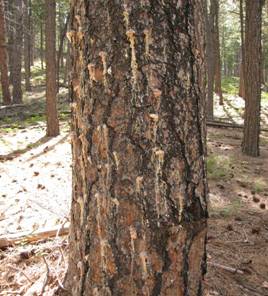
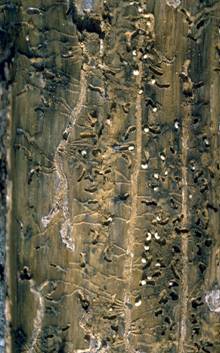 Boring through the bark, the pine beetle kills its host by disrupting the movement of food from the needles to the roots through the construction of tunnels known as galleries underneath the bark of the tree. Here the pine beetles lay their eggs in late summer/early fall. Each beetle also carries a fungus known as blue stain from tree to tree; blue stain fungi plug the water-conducting tissue of the tree, blocking the flow of water from the roots to the needles. This combined attack almost always kills an infected tree within one year. Soon the eggs hatch into the larvae stage, which then become dormant in preparation for winter. In the process, the larvae produce glycol, similar to motor antifreeze, which allows them to be nearly immune to any cold temperatures they might experience during the winter. The following spring, the larvae continue to mature and complete their metamorphosis into the adult stage.
Boring through the bark, the pine beetle kills its host by disrupting the movement of food from the needles to the roots through the construction of tunnels known as galleries underneath the bark of the tree. Here the pine beetles lay their eggs in late summer/early fall. Each beetle also carries a fungus known as blue stain from tree to tree; blue stain fungi plug the water-conducting tissue of the tree, blocking the flow of water from the roots to the needles. This combined attack almost always kills an infected tree within one year. Soon the eggs hatch into the larvae stage, which then become dormant in preparation for winter. In the process, the larvae produce glycol, similar to motor antifreeze, which allows them to be nearly immune to any cold temperatures they might experience during the winter. The following spring, the larvae continue to mature and complete their metamorphosis into the adult stage.
Once a tree is attacked, it is too late to do anything to save it. The best prevention against mountain pine beetles is maintaining less stocked, lower susceptible stands. This means having a healthy, thinned forest that is unattractive to pine beetles and does not allow them the opportunity to infest.
For high-value areas such as immediately around homes, it is advisable to spray trees if there is noticeable activity in the area. Spraying involves applying chemical to the bark on the bottom 30-40’ of the tree, ahead of the mountain pine beetle flight in late summer. Ideally, the best time to spray trees are in the spring time. Check which local chemical companies for pricing and availability.
It is also recommended to monitor forested areas that are at risk for infestations. Sanitation, or the removal of green-infested trees, is a very important method to stave off major infestation. If possible, remove green-infested trees from the site. A commercial timber harvest can facilitate removal of these green infested trees, but when unfeasible, ‘cutting & chunking’ the infested tree into 2’ sections is effective in killing the beetles.
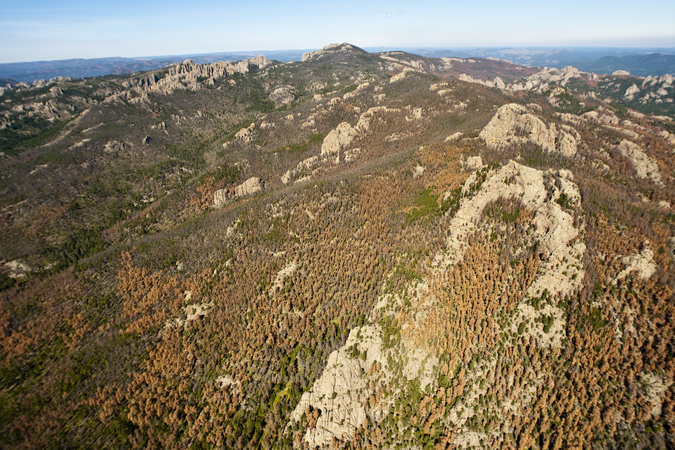
The devastating effects of a mountain pine beetle outbreak through the Black Elk Wilderness. Photo courtesy of forestphoto.com
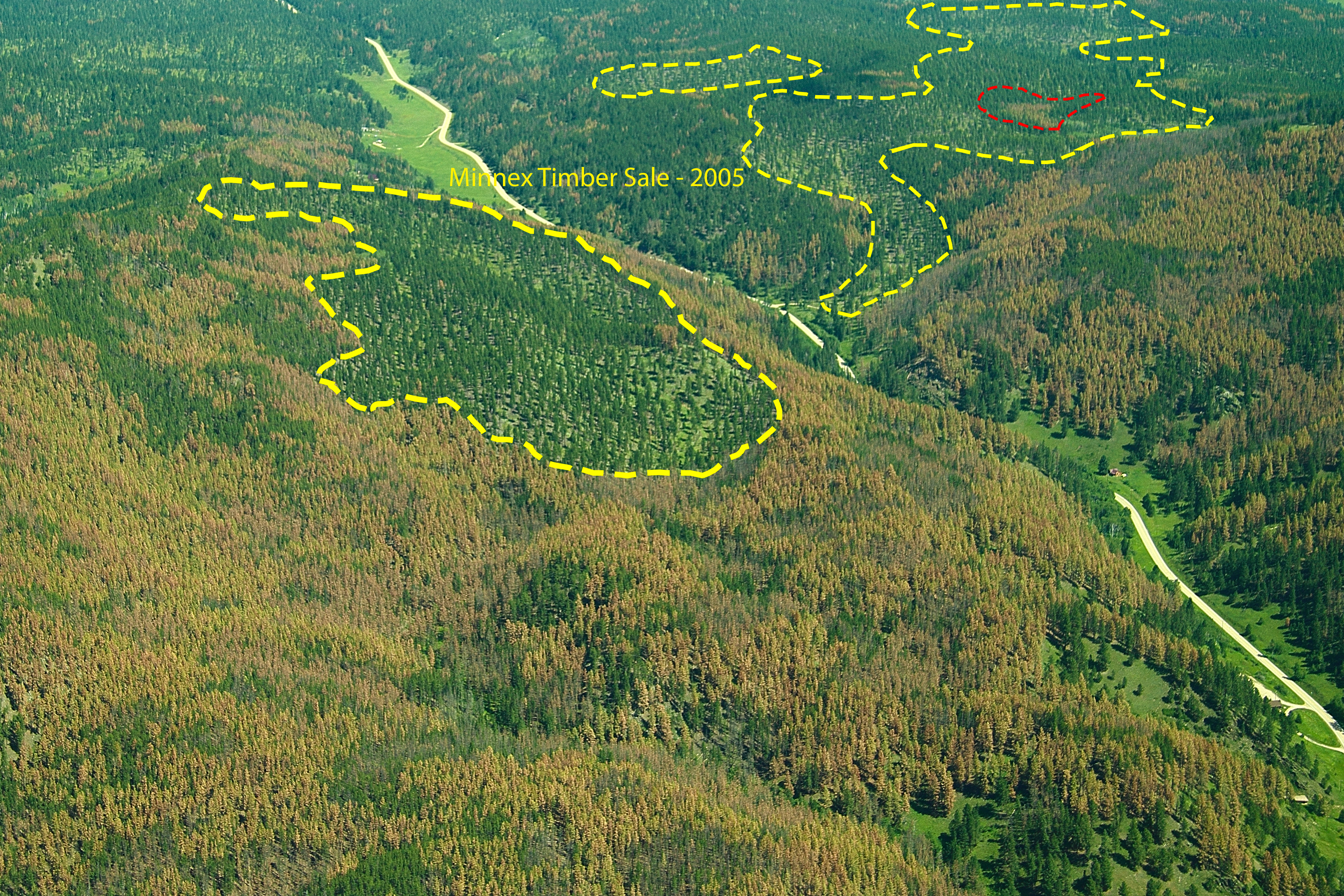
Areas thinned by timber harvest (within yellow lines) resist beetle infestation and extensive mortality.
The future of beetle impacted forests
Go anywhere in the Black Hills and it is clear the forest has been subjected to a devestating mountain pine beetle epidemic. However, while some areas have lost a substantial portion of the mature trees, many beetle impacted areas have a component of young trees that will release and grow much quicker – similar to following a timber harvest. Barring any further disturbance, these stands of young trees will begin recruitment into the overstory. Unfortunately, the likelihood of another disturbance has been significantly heightened as the dead trees fall to the forest floor and accumulate as fuel for catastrophic wildfires. Forest recovery could be set back hundreds of years if such a fire burns through these stands of beetle impacted forest. Evidence of this can be found in the footprint of Jasper Fire which burned in 2000. Fifteen years later, areas that burned at high severity have yet to begin recovering to forested conditions.
